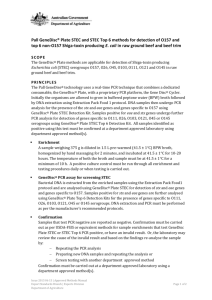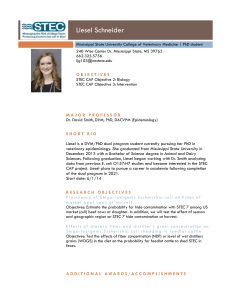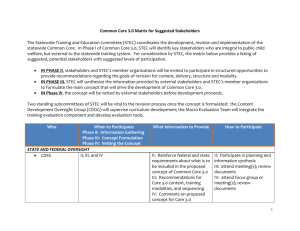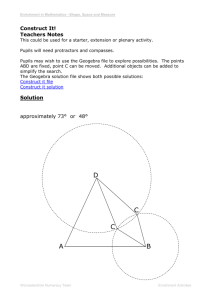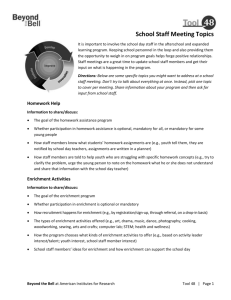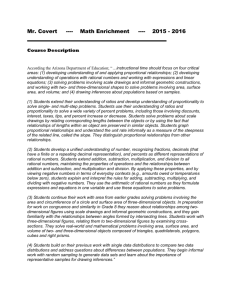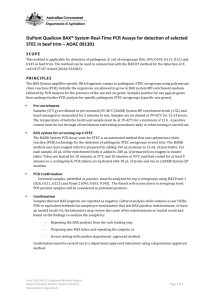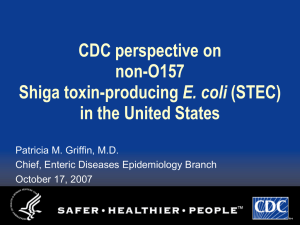Assurance GDS® MPX Top 7 STEC for detection of pathogenic
advertisement
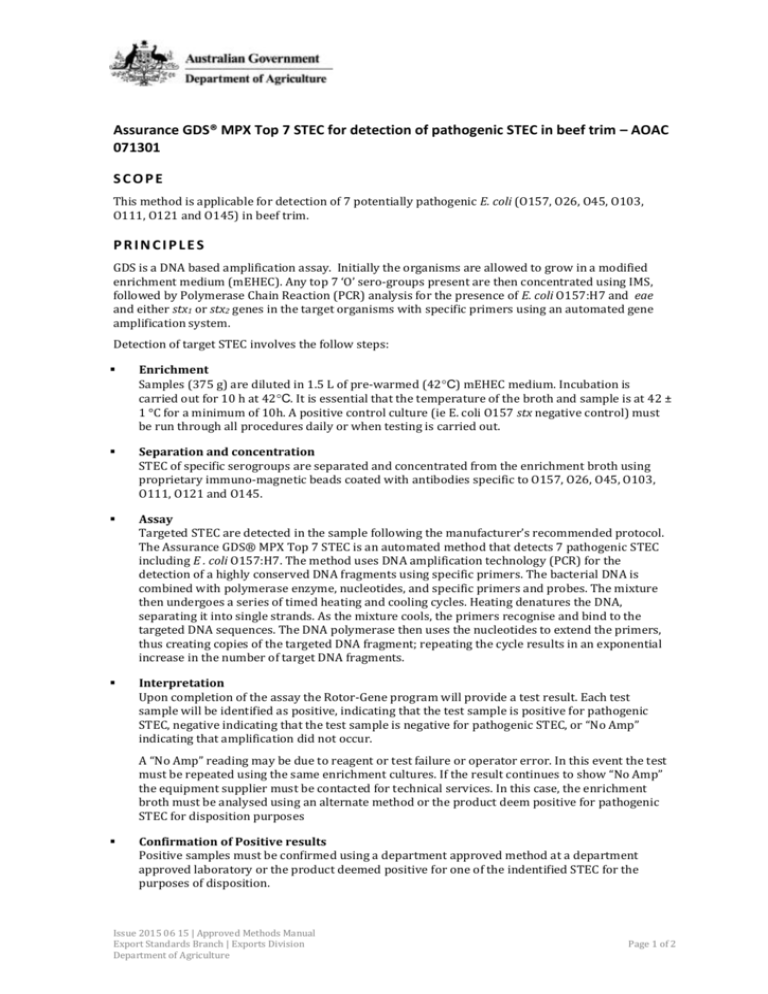
Assurance GDS® MPX Top 7 STEC for detection of pathogenic STEC in beef trim – AOAC 071301 SCOPE This method is applicable for detection of 7 potentially pathogenic E. coli (O157, O26, O45, O103, O111, O121 and O145) in beef trim. PRINCIPLES GDS is a DNA based amplification assay. Initially the organisms are allowed to grow in a modified enrichment medium (mEHEC). Any top 7 ‘O’ sero-groups present are then concentrated using IMS, followed by Polymerase Chain Reaction (PCR) analysis for the presence of E. coli O157:H7 and eae and either stx1 or stx2 genes in the target organisms with specific primers using an automated gene amplification system. Detection of target STEC involves the follow steps: Enrichment Samples (375 g) are diluted in 1.5 L of pre-warmed (42C) mEHEC medium. Incubation is carried out for 10 h at 42C. It is essential that the temperature of the broth and sample is at 42 ± 1 °C for a minimum of 10h. A positive control culture (ie E. coli O157 stx negative control) must be run through all procedures daily or when testing is carried out. Separation and concentration STEC of specific serogroups are separated and concentrated from the enrichment broth using proprietary immuno-magnetic beads coated with antibodies specific to O157, O26, O45, O103, O111, O121 and O145. Assay Targeted STEC are detected in the sample following the manufacturer’s recommended protocol. The Assurance GDS® MPX Top 7 STEC is an automated method that detects 7 pathogenic STEC including E . coli O157:H7. The method uses DNA amplification technology (PCR) for the detection of a highly conserved DNA fragments using specific primers. The bacterial DNA is combined with polymerase enzyme, nucleotides, and specific primers and probes. The mixture then undergoes a series of timed heating and cooling cycles. Heating denatures the DNA, separating it into single strands. As the mixture cools, the primers recognise and bind to the targeted DNA sequences. The DNA polymerase then uses the nucleotides to extend the primers, thus creating copies of the targeted DNA fragment; repeating the cycle results in an exponential increase in the number of target DNA fragments. Interpretation Upon completion of the assay the Rotor-Gene program will provide a test result. Each test sample will be identified as positive, indicating that the test sample is positive for pathogenic STEC, negative indicating that the test sample is negative for pathogenic STEC, or “No Amp” indicating that amplification did not occur. A “No Amp” reading may be due to reagent or test failure or operator error. In this event the test must be repeated using the same enrichment cultures. If the result continues to show “No Amp” the equipment supplier must be contacted for technical services. In this case, the enrichment broth must be analysed using an alternate method or the product deem positive for pathogenic STEC for disposition purposes Confirmation of Positive results Positive samples must be confirmed using a department approved method at a department approved laboratory or the product deemed positive for one of the indentified STEC for the purposes of disposition. Issue 2015 06 15 | Approved Methods Manual Export Standards Branch | Exports Division Department of Agriculture Page 1 of 2 Assurance GDS® MPX Top 7 STEC – AOAC 071301 CHECKLIST Enrichment Is the sample enriched in mEHEC medium prewarmed at 42C before use? Is enrichment carried out 42C and is the enrichment broth and sample at 42 °C for a minimum of for 10 h? Is the correct amount of enrichment broth used (ie 1.5L mEHEC broth)? Is a positive control run with each batch of samples/daily? Are reference cultures inoculated into enrichment media at a level of 10-100 cells/mL? Assay Are manufacturer’s instructions available for reference? Are internal controls run with each batch of samples? Are technicians familiar with and trained in the operation of the GDS® MPX Automated System and the Rotor-Gene Program? Is the shelf-life of media and kits controlled? Confirmation Is confirmation carried out from the enrichment culture using IMS? Is confirmation carried out using an approved method at a department approved laboratory? Issue 2015 06 15 | Approved Methods Manual Export Standards Branch | Exports Division Department of Agriculture Page 2 of 2
